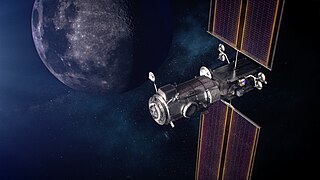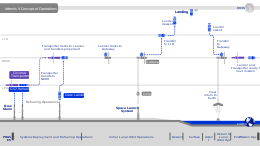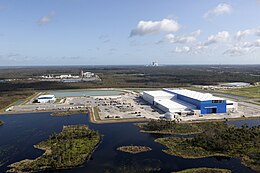Human spaceflight programs have been conducted, started, or planned by multiple countries and companies. Until the 21st century, human spaceflight programs were sponsored exclusively by governments, through either the military or civilian space agencies. With the launch of the privately funded SpaceShipOne in 2004, a new category of human spaceflight programs – commercial human spaceflight – arrived. By the end of 2022, three countries and one private company (SpaceX) had successfully launched humans to Earth orbit, and two private companies had launched humans on a suborbital trajectory.

Blue Origin Enterprises, L.P., commonly referred to as Blue Origin is an American aerospace manufacturer, defense contractor, launch service provider and space technologies company headquartered in Kent, Washington, United States. The company makes rocket engines for United Launch Alliance (ULA)'s Vulcan rocket and manufactures their own rockets, spacecraft, satellites, and heavy-lift launch vehicles. The company is the second provider of lunar lander services for NASA's Artemis program and was awarded a $3.4 billion contract. The four rocket engines the company has in production are the BE-3U, BE-3PM, BE-4 and the BE-7.

Masten Space Systems was an aerospace manufacturer startup company in Mojave, California that was developing a line of vertical takeoff, vertical landing (VTVL) rockets, initially for uncrewed research sub-orbital spaceflights and eventually intended to support robotic orbital spaceflight launches.

A moonbase, lunar base, or lunar colony is a facility on or below the surface of the Moon, enabling human activity on the Moon. As such, it is different from a lunar space station in orbit around the Moon, like the planned Lunar Gateway of the Artemis program. Moonbases can be for robotic or human use, in both cases not necessarily including lunar habitation facilities.

Dynetics is an American applied science and information technology company headquartered in Huntsville, Alabama. Its primary customers are the United States Department of Defense (DoD), the United States Intelligence Community, and National Aeronautics and Space Administration (NASA).

Artemis 3 is planned to be the first crewed Moon landing mission of the Artemis program and the first crewed flight of the Starship HLS lander. Artemis 3 is planned to be the second crewed Artemis mission and the first American crewed lunar landing since Apollo 17 in December 1972. In December 2023, the Government Accountability Office reported that the mission is not likely to occur before 2027; as of January 2024, NASA officially expects Artemis 3 to launch no earlier than September 2026 due to issues with the valves in Orion's life support system.

The billionaire space race is the rivalry among entrepreneurs who have entered the space industry from other industries - particularly computing. This private spaceflight race involves sending privately developed rockets and vehicles to various destinations in space, often in response to government programs or to develop the space tourism sector.

The Lunar Gateway, or simply Gateway, is a space station which Artemis program participants plan to assemble in an orbit near the Moon. The Gateway is intended to serve as a communication hub, science laboratory, and habitation module for astronauts. It is a multinational collaborative project: participants include NASA, the European Space Agency (ESA), the Japan Aerospace Exploration Agency (JAXA), the Canadian Space Agency (CSA) and the Mohammed Bin Rashid Space Centre (MBRSC). The Gateway is planned to be the first space station beyond low Earth orbit.

Starship is a two-stage super heavy-lift launch vehicle under development by SpaceX. As of April 2024, it is the largest and most powerful rocket ever flown. Starship's primary objective is to lower launch costs significantly via economies of scale. This is achieved by reusing both rocket stages, increasing payload mass to orbit, increasing launch frequency, creating a mass-manufacturing pipeline, and adapting it to a wide range of space missions. Starship is the latest project in SpaceX's decades-long reusable launch system development program and ambition of colonizing Mars.

The Intuitive Machines Nova-C, or simply Nova-C, is a class of lunar landers designed by Intuitive Machines (IM) to deliver small payloads to the surface of the Moon. Intuitive Machines was one of three service providers awarded task orders in 2019 for delivery of NASA science payloads to the Moon. The IM-1 lunar lander, named Odysseus, was launched by a SpaceX Falcon 9 rocket on 15 February 2024, reached lunar orbit on 21 February, and landed on the lunar surface on 22 February. This marked the inaugural Nova-C landing on the Moon and the first American spacecraft to perform a soft landing on the Moon in over 50 years. It is the first spacecraft to use methalox propulsion to navigate between the Earth and the Moon.

The Artemis program is a Moon exploration program that is led by the United States' National Aeronoautics and Space Administration (NASA) and was formally established in 2017 via Space Policy Directive 1. The Artemis program is intended to reestablish a human presence on the Moon for the first time since the Apollo 17 moon mission in 1972. The program's stated long-term goal is to establish a permanent base on the Moon to facilitate human missions to Mars.

Artemis 4 is a planned mission of the NASA-led Artemis program. The mission will include the fourth use of a Space Launch System (SLS) launch vehicle, will send an Orion spacecraft with four astronauts to the Lunar Gateway space station, install a new module on the Gateway, and conduct the second lunar landing of the Artemis program.

Artemis 5 is the fifth planned mission of NASA's Artemis program and the first crewed flight of the Blue Moon lander. The mission will launch four astronauts on a Space Launch System rocket and an Orion to the Lunar Gateway and will be the third lunar landing of the Artemis program. In addition, Artemis V will also deliver two new elements to the Gateway Space Station.

Starship HLS is a lunar lander variant of the Starship spacecraft that is slated to transfer astronauts from a lunar orbit to the surface of the Moon and back. It is being designed and built by SpaceX under the Human Landing System contract to NASA as a critical element of NASA's Artemis program to land a crew on the Moon.
The Integrated Lander Vehicle (ILV) was a human spaceflight lunar lander design concept proposed in 2020/21 for the NASA Human Landing System (HLS) component of the Artemis program. Blue Origin was the lead contractor for the multi-element lunar lander that was to include major components from several large US government space contractors including Lockheed Martin, Northrop Grumman, and Draper Laboratory.
The Dynetics Autonomous Logistics Platform for All-Moon Cargo Access (ALPACA)—also known as Dynetics HLS—(ILV) is a human spaceflight lunar lander design concept proposed in 2020/21 for the NASA Human Landing System (HLS) component of the Artemis program. Dynetics was the lead contractor for the ALPACA lander—other contractors included Sierra Nevada Corporation—for NASA's Artemis Program.
A Human Landing System (HLS) is a spacecraft in NASA's Artemis program that is expected to land humans on the Moon. These are being designed to convey astronauts from the Lunar Gateway space station in lunar orbit to the lunar surface, sustain them there, and then return them to the Gateway station. As of 2024 NASA intends to use Starship HLS for Artemis III, an enhanced Starship HLS for Artemis IV, and a Blue Origin HLS for Artemis V.

On 13 August 2021, Blue Origin filed a complaint to the United States Court of Federal Claims about NASA's award of $2.9 billion to SpaceX. The award was used by the company to further develop Starship HLS, a lunar lander that NASA selected for the Artemis program. On 4 November 2021, the Court of Federal Claims dismissed the complaint, and the accompanying memorandum opinion was titled Blue Origin v. United States & Space Exploration Technologies Corp. Blue Origin's complaint and prior actions have received attention from the news media and spaceflight industries.

















